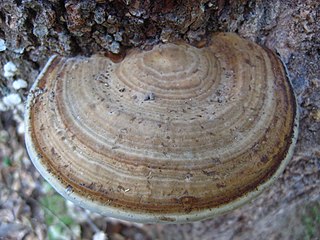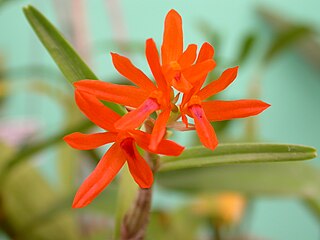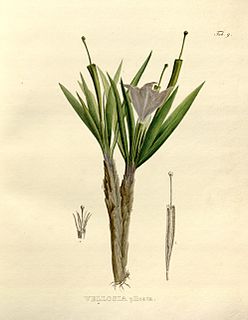Related Research Articles

Carl Sigismund Kunth, also Karl Sigismund Kunth or anglicized as Charles Sigismund Kunth, was a German botanist. He is known for being one of the first to study and categorise plants from the American continents, publishing Nova genera et species plantarum quas in peregrinatione ad plagam aequinoctialem orbis novi collegerunt Bonpland et Humboldt.

Eduard Friedrich Poeppig was a German botanist, zoologist and explorer.

Tetrorchidium is a genus of flowering plants in the family Euphorbiaceae first described in 1841. It is native to tropical portions of Africa and the Western Hemisphere.

Dalechampia dioscoreifolia is a species of plant in the family Euphorbiaceae first described in 1841. It is native to Central America and northern and western South America.

Fomes fasciatus is species of fungus in the family Polyporaceae. It a plant pathogen that causes white rot of heartwood of hardwoods. Originally described in 1788 by Swedish botanist Olof Swartz from specimens collected in Jamaica, it is also found in North America.

Cyclanthus a genus of plants in the family Cyclanthaceae, first described as a genus in 1824. It is native to tropical Latin America and the West Indies. It consists of large, palm-like monocots.

Cyclanthus bipartitus a species of plant in the family Cyclanthaceae, first described as a genus in 1824. It is native to southern Mexico, Central America, Trinidad, Windward Islands, northern South America.

Comparettia, abbreviated Comp in the horticultural trade, is a genus of orchids. It consists about 50-70 species, native to tropical America. They occur in Mexico, Central America, the West Indies, and in northern South America as far south as Brazil and Bolivia, although they are particularly common in the Andes. The genus has grown markedly in recent years due to many species being transferred from other genera.

Scaphyglottis is a genus of orchids native to Mexico, Central America, northern South America and parts of the Caribbean. The current concept of this genus is the result of combining several genera which have been described at various times. The concept is characterized by the growth habit: not only are new pseudobulbs added at the base of the old ones, but new pseudobulbs also grow at the apices of the old ones. Many species are quite similar and difficult to distinguish, but some are clearly distinct. A few have showy colors. The genus comprises nearly 70 species.
Enumeratio plantarum quas in Novae Hollandiæ ora austro-occidentali ad fluvium Cygnorum et in sinu Regis Georgii collegit Carolus Liber Baro de Hügel is a description of the plants collected at the Swan River colony and King George Sound in Western Australia. The author, Stephan Endlicher, used a collection arranged by Charles von Hügel to compile the first flora for the new settlements. Hugel visited the region during 1833-1834, several years after the founding of the colony. The work provided formal descriptions, in Latin, of new species and genera of plants. The single installment was produced in Europe by Endlicher in 1837, the work also included contributions by Eduard Fenzl, George Bentham, Heinrich Wilhelm Schott.
Garcilassa is a genus of flowering plants in the sunflower family.

Paranephelius is a genus of South American plants in the Liabum tribe within the daisy family.

Eduard Fenzl was an Austrian botanist.

Nanuza plicata is a plant species in the family Velloziaceae, endemic to Brazil.

Nanuza is a plant genus in the family Velloziaceae, described as a genus in 1976. The entire genus is endemic to Brazil.
Xiphochaeta is a genus of South American plants in the Vernonieae tribe within the daisy family.

Qualea parviflora, known as pau-terra in Portuguese, is a deciduous tree indigenous to Bolivia, Brazil, and Paraguay. The tree favors dry climates like the tropical savanna of the cerrado.
References
- ↑ Poeppig, Eduard Friedrich. 1843. Nova genera ac species plantarum, quas in regno Chilensi Peruviano et in terra Amazonica 3: 50-51 in Latin
- ↑ Poeppig, Eduard Friedrich. 1843. Nova genera ac species plantarum, quas in regno Chilensi Peruviano et in terra Amazonica 3: plate CCLVII (257) color illustration and line drawings
- ↑ Tropicos, Oriastrum Poepp.
- ↑ The Plant List search for Oriastrum